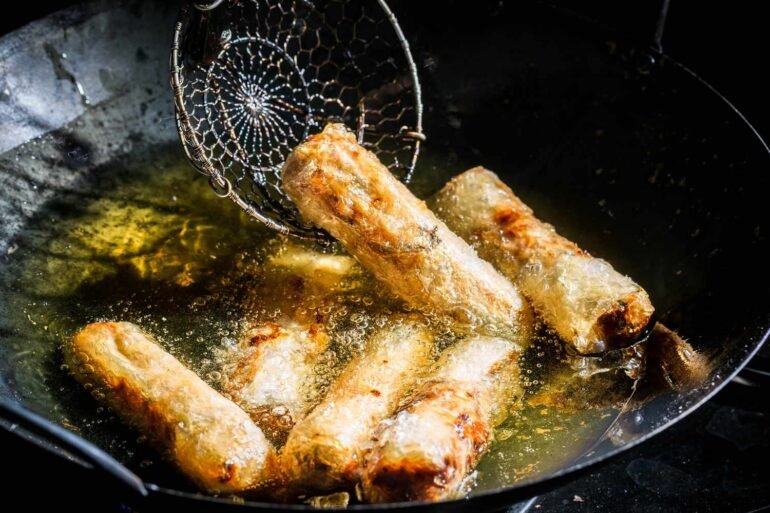:max_bytes(150000):strip_icc():format(jpeg)/Fear-of-Frying-FT-DGTL1025-a1e67e9a21654ceda0fb22be48643230.jpg)
With its signature crunch, properly fried food satisfies like nothing else. From Southern fried chicken and catfish to New England cider doughnuts and New Orleans beignets, fried delicacies adorn countless American tables. Every culture around the world has its own golden specialty, dishes like Japanese tempura, Indian pakoras and samosas, and Middle Eastern falafel.
Flavors and ingredients may differ, but the basic requirements don’t change: good oil, steady heat, dry food, and your full attention. Ignore those, and you get heavy grease and painful splatter. Respect them, and you get food that’s light, crisp, and deeply satisfying. For foolproof frying, nail these top five basics.
Pick the perfect pot (and tools)
The fastest way to fry with confidence? Start with the right equipment. A simple upgrade from thin, lightweight pans to sturdier ones can improve safety, keep oil temperatures steady, and deliver the crisp, golden results that make frying worth it.
For deep-frying, rely on a countertop fryer or a heavy pot that’s wide and deep enough to hold 2 to 6 inches of oil, with plenty of room at the top to prevent sloshing or overflow when food is added. For shallow frying, pick a cast-iron or other sturdy skillet that can hold 1/2 inch to 1 inch of oil, that conducts heat evenly, and has enough weight to stay stable on the burner. And for specialty frying, like a whole turkey, stick with a sturdy outdoor setup built for the job, not a DIY setup like a stockpot rigged over a makeshift burner.
Before you start, gather your frying tools. If you’re deep-frying without a dedicated fryer, you’ll need a reliable thermometer (such as a candy thermometer) that can be clipped to the pot and a spider strainer or slotted spoon to lift food quickly and drain off excess oil. For shallow frying, heat-resistant tongs work well for turning foods like chicken pieces in the pan; use a slotted spoon or spatula to handle delicate food. Keep a tray or baking sheet beside the stove for resting utensils on, and paper towels or a brown paper bag for blotting oil. Use a baking sheet fitted with a rack to keep food crisp and to hold in the warm oven while finishing remaining batches.
Frying checklist
- Countertop fryer or heavy, wide pot (for deep-frying)
- Cast-iron or other sturdy skillet (for shallow-frying)
- Candy thermometer (if you don’t have a dedicated fryer)
- Spider spoon, slotted spoon, or tongs
- Neutral oil
- Paper towels or brown paper bag (for blotting)
- Baking sheet fitted with rack
If the oil’s wrong, everything else will be, too
You don’t have to be a food scientist to fry food, but it helps to know a few basics about oil — mainly its smoke point, refinement, and stability.
Smoke point is the temperature where oil starts to break down — and if you push past it, it can even catch fire. Refinement describes how much an oil has been processed to remove solids, impurities, and aromas. Refined oils like canola have been filtered to remove solids and impurities, which gives them higher smoke points and stability at high temperatures. Unrefined or virgin oils are less processed, more flavorful, and degrade and smoke faster under high heat. Stability is about how well oil holds up to heat and reuse. The more stable it is, the cleaner the flavor, the higher the smoke point, and the crisper the results — especially if you strain out stray bits of food between batches.
When you’re standing in the grocery aisle, look for oils that stay stable at high heat. For deep-frying, refined oils like canola, peanut, sunflower, safflower, and grapeseed are your best bet — they all have high smoke points and neutral flavor.
For shallow frying, you have a little more flexibility. You can still use those same refined oils, but you can also reach for extra-virgin olive oil or unrefined coconut oil if you’re cooking over moderate heat and watching the pan. Both have lower smoke points, so they work best for quick, shallow fries — think cutlets, fritters, or eggs — but not for deep or prolonged frying.
Food & Wine / Photo by Brie Goldman / Food Styling by Annie Prost / Prop Styling by Addelyn Evans
Hot oil and water don’t mix
Remember the movie Gremlins? Take the shopkeeper’s warning as your frying oil mantra: Don’t get it wet. The reign of terror that water unleashed on those kids in the ’80s classic isn’t too different from what happens when water meets hot oil. Even the smallest drop can cause a punishing spray of scalding oil to sizzle, pop, and splatter.
Make sure your ingredients are dry before they go into the pan. Blot fish and vegetables thoroughly with paper towels, or let them air-dry. Thin batters and marinades can cause trouble too, so use the standard breading procedure — flour, egg, then crumbs or cornmeal — to keep the wet ingredients cushioned behind a protective coating of dry ones.
There is one exception: batter-fried foods like tempura and fritters. They’ll sizzle, but they won’t create a violent splatter. Their moisture is bound by dry ingredients, which turn that water into steam instead of chaos. Drop in a wet piece of chicken or waterlogged vegetable, however, and you’ll send up a shower of hot oil.
Never leave the scene of the fry
When you’re frying, attentiveness is one of the most important cooking skills you’ve got. Walking away for even a moment is a risk — and not just for burnt food. Remember that smoke point? Oil can reach it fast. Leave a burner unchecked, and your oil can overheat, smoke, or even catch fire.
The best way to keep from walking away? Make it impossible to need to. Set up your station before you turn on the heat, and make sure everything is within arm’s reach. Save other cooking tasks for when the frying’s done, and use a timer to help keep you anchored. Listen to the oil: Steady sizzling and bubbling mean there’s good action in the pan. Complete silence — or loud sputtering and popping — means something’s off.
Don’t make a splash
Ease food into hot frying oil — that’s the number one move that keeps burns at bay and turns frying from a nail-biter into a calm, controlled process. Use a spider, slotted spoon, or tongs to add food when deep-frying rather than dropping it in, especially from a height. For shallow frying, adding food by hand is fine — just lower it in gently rather than tossing.
That slow, steady entry keeps oil from splattering and helps the temperature stay steady. It’s the key to ensuring that food cooks evenly and crisps rather than soaking up fat and becoming greasy. Dropping food into the pan or pot too forcefully can send oil over the pan sides, where it can ignite on a flame or burner. A gentle approach and an even hand are what separate the calm, successful fryers from the hesitant ones.
Cheryl Slocum
2025-10-16 12:29:00

